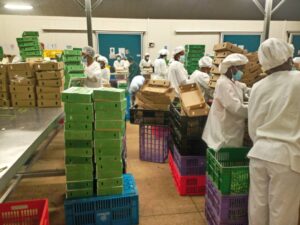By Jean Baptiste Ndabananiye
Food valued at billions of dollars spoils every year, before it reaches a plate. Did you know that 526 million tons of food, which suffices to nourish about a billion mouths, are lost every year due to inadequate cold chains? Nevertheless, in a Kenyan cooperative, about 180 farmers are proving that cold chains can turn the current waste into wealth. In the bustling cold rooms of the cooperative, a revolution is quietly taking place—one that could reshape how the world feeds itself. This cooperative serves as a powerful example of how this global crisis can be tackled.

Meanwhile, a groundbreaking gathering—the Festival of Cooling, the first event of its kind worldwide, organized by the Africa Center of Excellence for Sustainable Cooling and Cold-chain (ACES), was held in Rwanda from 7 to 10 October 2025. In this unprecedented event, Life In Humanity thus grabbed the unique opportunity to engage directly with pioneers transforming agricultural practices through sustainable cold chains. Among them was Zachary Kibiri, from the Kenyan cooperative—Lari Horticulture Cooperative Society (LHCS) which is setting new standards in post-harvest preservation.
Kibiri’s insights offer a vivid, ground-level perspective on the challenges and transformative potential of cold chains in agriculture. From minimizing post-harvest losses and preserving the quality of produce, to enabling farmers to access distant markets and command better prices, his experience illustrates how access to temperature-controlled logistics is no longer a luxury—it forms a lifeline for farmers, local economies, and food security.
Against the backdrop of Rwanda’s pioneering Festival, Kibiri shared firsthand how refrigerated trucks, cold rooms, and precise temperature management are revolutionizing the cooperative’s operations, safeguarding perishable crops like bananas, carrots, and spinach, and drawing young people back into farming. His story provides a microcosm of the global challenge: inadequate cold chains not only threaten livelihoods and economic growth, but also compromise food security for hundreds of millions worldwide. This article explores the pressing issues to be handled to ensure effective cooling for food across the world, blending Kibiri’s local experience with some wider international findings that underscore the urgency of expanding sustainable cold chain infrastructure.
LHCS’s cold chain revolution: from local losses to global lessons
Kibiri says “First of all, I would like to say without a cold chain, farmers are experiencing a lot of losses. I would say that in most regions especially in horticulture, without a cold chain, farmers are experiencing as high as 50% of their produce going to waste. Farmers can only experience (use) the cold chain, to be able to minimize these post-harvest losses, and also farmers can be able to access the market in a more comfortable way, using the cold chain because the farmers can be able to preserve the quality of their produce.

Through the cold chain, they can also be in a position to bargain for a better market, because of the freshness of their produce. Through the cold chain, farmers can also be in a position to do value addition. All these benefits come in, when you have a cold chain. Without a cold chain, even maintaining the quality of the produce is difficult; the consumer gets a substandard product.”
In business, the word “chain” refers to a series of connected stages, activities, or entities that work together to deliver a product or service from its origin to the end user. In the same sector ‘business’, supply chain means the entire network of production and distribution that moves a product from raw materials to the consumer.
The cold chain constitutes a specialized part of the supply chain that deals with temperature-sensitive products like food, vaccines, or medicines. The cold chain refers to the temperature-controlled supply chain used to preserve and transport perishable products—such as vegetables and other temperature-sensitive goods—from the point of production to the final consumer. It involves a series of refrigerated production, storage, and distribution processes that maintain products within a specific temperature range to prevent spoilage, degradation, or loss of quality.
For instance, in food logistics, the cold chain ensures that fish, dairy, fruits, and vegetables remain fresh until they reach the market. In healthcare, it ensures that vaccines remain effective by keeping them at the correct temperature during storage and transport. In short, the cold chain constitutes a continuous system of refrigeration that safeguards perishable goods from production to consumption.
Kibiri underlines “For you to be able to maintain the quality, bargain for better prices and also to be able to transport [the produce to various markets], you can only have a cold chain to supply the produce in all regions where your market may be. You find that in most of our regions in Africa, we have very warm weather and during the transportation, most of the produce loses freshness and even gets spoilt. For the consumer to get the product of the highest quality, it can only be through the cold chain.”
Temperature precision— the secret to prolonging freshness
Ensuring that harvested crops remain fresh and of high quality requires careful temperature control at every stage of the supply chain. As explained by Kibiri, refrigerated trucks and cold rooms play a vital role in maintaining the right temperatures for each crop—from aggregation and packing to transportation and storage—helping produce like bananas, carrots, and spinach to stay fresh for not less than a week.

He says “We have trucks which are refrigerated, to maintain certain temperatures which will be able to prevent the spoilage of our produce. So, through the process, after aggregation, you put them in a cold room at certain temperatures, depending on the crop; and then, after grading and packing, you still have refrigerated trucks which can now transport to various regions and after getting to the destination, you can still preserve them in a cold room at specified temperatures. So it can last long when maintained in the right conditions.
All crops are not kept at the same temperature. Different crops for example banana, carrots and spinach cannot be put in the same temperatures, because if you put them in the same temperature, some products get spoilt, because a certain temperature may be very high for a certain crop. So, there is a specification per crop, the temperature which is suitable for a particular crop. So, if you maintain it at that temperature, it can last longer. Leaf vegetables, carrots and bananas— if kept at the right temperatures— last longer. The experience I have is that we keep some products up to eight days and they are still of good quality.”
Preservation power—how cooling technology has tripled farmers’ earnings
Comparison— between the time when they had not started using the cooling chamber and now that they employ it—reveals remarkable progress. According to Kibiri, “Formerly before using the cold room, we used to experience about 40% post-harvest losses. After starting to use the cold room, we are now able to reduce the post-harvest losses to about 10%; which means the 30% already is being sold and formerly we used to lose it. On top of that, we are selling at a better price than we used to. Formerly, we could not be able to get a good market, because we didn’t have opportunity to bargain for better prices. This time, we are able to get good prices, because it [our produce] is preserved.

I can say; for instance, we used to sell a cabbage at about 15 or 20 Kenyan shillings. This time, we are able to get as high as 55 to 60 shillings per piece [cabbage]; which is almost three times the price we used to get. At the same time, we are able to deliver to distant markets, because we are not losing the quality of the product. Formerly, we could not deliver to those distant markets, because it could get spoilt even before getting there.”
To the question whether they can’t ensure that there happens zero produce loss from the current 10% waste, Kibiri responds “Actually, the remaining 10%, that one is only because we are not taking entirely whatever we are growing because some markets demand a certain quality. The small sizes [crops smaller than the preferred or standard size] are not absorbed into the market. We are intending to do value addition. When you are doing value addition, you can be in a position to exploit the 10% we have been losing due to sizes, you can process almost everything. That one [10%] is even sorted out even before, it doesn’t get into the cold room.
When we shall be doing value addition, the size does not matter; as long as the product is not infected with diseases or attacked by the pest, you can be able to utilize it. Considering that we have good agricultural practices, we can be able to utilize the 10%, and we can reduce the losses and maximize on profit, because when we can be able to sell about 95% or 97% of the produce, that is a benefit to the farmer.”
Reviving farming: how cold chains have transformed the community
Kibiri explains transformations— in the cooperative’s community—which have been born out of the use of the cold chain. “One thing is that the farmers are satisfied, they get better prices; which enables them to cater for their expenses in the farm. And also considering that it has a better income, it is able to attract young people. Formerly, young people were not interested in farming because they found it was a tiresome job without a return. And now we are able to get good prices from the produce, even young people are attracted to do farming. And because we are introducing high-value crops; for example, like broccolis, tomatoes—those are able to have a better return. So, young people can be able to do farming in a small piece of land and can get a good income.”

To specify, he says “Not below 60% of our cooperative society’s staff are young people. Even the manager himself is a young man, below 30 years [of age]. You find that young people have secured jobs and also from the membership of our farmers, we are having young people, retreating back to farm, to do farming because they can see the benefit. Personally, I have my own son who was doing Master’s in Horticulture, but he is having his own greenhouses and he is doing about two hectares of horticulture, because he found there is a market and he can be able to make money from farming.
Formerly, before the cold chain, the cooperative was composed of old people. As the chairman of the board, I was the youngest in the board; others were above 55. But all people we are engaging are young, the oldest in our staff is 35 years old; but all others are below that. We are finding better and more response from the community, the young people appreciated farming; our technologists who are managing the cold room are young people, our drivers are also young. Formerly, 80% were old people; currently young people are over 60% and we are expecting almost 100% within two years.”
Any field infused with the energy and innovation of youth inevitably experiences remarkable progress. The same holds true for farming, where young minds can drive transformation through creativity, technology, and modern practices. In Africa—home to the world’s largest youth populations—greater youth participation in agriculture would assuredly propel the sector to stunning new heights. This potential is already visible in initiatives like the cooperative of Kibiri whose experience mirrors findings at the global level: inadequate cold chains cost billions and jeopardize food security worldwide.
The situation across the globe
Sustainable Energy for All (SE for All) published a 2022-year document headlined “Cooling for food, nutrition and agriculture” where it underlines what Kibiri says. It states “A lack of access to sustainable cooling and cold chain threatens to put SDG2 out of reach and stunt the ability of agricultural economies to grow sustainably.
With access to sustainable cooling and cold chains, farmers can grow perishable, nutritious crops with confidence they will be able to transport them to markets that can deliver good prices. They can also use more income to create more jobs, including for women who are over half of the agricultural workforce in key developing markets.”
SDG stands for Sustainable Development Goal, and SDG 2 is one of the UN’s 17 SDGs. This SDG2 is designed to end hunger, achieve food security and improved nutrition and promote sustainable agriculture by 2030. “Hunger is the leading cause of death in the world. Our planet has provided us with tremendous resources, but unequal access and inefficient handling leaves millions of people malnourished. If we promote sustainable agriculture with modern technologies and fair distribution systems, we can sustain the whole world’s population and make sure that nobody will ever suffer from hunger again,” says Global Goals.org— the official website for the SDGs also known as the Global Goals. The latter ones are a set of 17 interlinked objectives adopted by the world’s leaders in 2015 to end poverty, protect the planet, and ensure global peace and prosperity by 2030.
Yet despite these global commitments and abundant resources, hunger is continuing to claim millions of lives each year. The Sudanese American Physicians Association— with its 16 April 2025 article entitled “How Many People and Children Starve to Death Every Day”— specifies the shocking situation with the following alarming statistics. “Hunger remains one of the biggest humanitarian crises today. Children are the most vulnerable. A child dies from hunger every 10 seconds, adding up to 3.1 million child deaths per year. Despite global efforts to reduce hunger, progress has stalled in recent years, especially in conflict zones like Sudan, where millions face extreme food insecurity.

Every year, around 9 million people die from hunger and hunger-related diseases—more than the combined deaths from AIDS, malaria, and tuberculosis. This means that approximately 24,657 people die from hunger every day. Globally, 822 million people are undernourished, meaning they do not get enough food to sustain a healthy life. The highest rates of hunger are found in Africa, where 20 percent of the population lacks sufficient food. In some regions, like eastern and southern Africa, this number is over 30 percent.While the number of hungry people decreased for decades, it has been rising again since 2015. Of the 822 million undernourished people worldwide, 113 million suffer from acute hunger, meaning they are in immediate need of food aid to survive.”
In the meantime, according to SE for ALL, the world is facing an alarming reality when it comes to food preservation and waste, and if no food loss, not even one person in the world could be starving. “13% of all [global] food production is lost due to lack of cold chain—526 m tonnes of food lost due to a lack of cold chains annually. 950 m people could be fed with food currently lost to broken cold chains. The cost of food loss and waste is estimated at nearly USD 1 trillion annually. Food is lost and wasted throughout various stages of the food supply chain, with 14 percent of all food produced lost between harvest and retail, and 17 percent of all food produced wasted in households, restaurants and across other food services. A 2018 study estimates that this figure will grow, with food loss and waste amounting to 2.1 billion tons of food annually, a global economic loss of USD 1.5 trillion in 2030 in a business-as-usual scenario.”
The Food and Agriculture Organization (FAO) has released an undated piece of writing entitled “Sustainable Food Cold Chains.” It also stresses “The lack of effective refrigeration is a leading contributor to this challenge, directly resulting in the loss of 526 million tons of food production, or 12 per cent of the global total, in 2017 (International Institute of Refrigeration [IIF/IIR] 2021a).
This is enough to feed an estimated 1 billion people in a world where currently 811 million people are hungry and 3 billion are unable to afford a healthy diet (FAO 2022). The unavailability of robust food cold chains to maintain the quality, nutritional value and safety of food products has ramifications for people’s health.”
As already highlighted, every year, the world loses about 526 million tonnes of food because there don’t exist enough cold chains to keep it fresh. To understand what that means, imagine how much food one person eats in a year. On average, a person consumes about 550 kilograms (a little more than half a tonne) of food annually.
Now, if you divide the 526 million tonnes of food lost by the 0.55 tonnes one person eats, you get: 526,000,000÷0.55=956,000,000. That signifies that the food wasted each year because of broken or missing cold chains could feed about 950 million people— for an entire year— the number which SE for All has already mentioned. Since the world currently counts around 800 million people going hungry, this lost food would suffice to feed every hungry person—and still have some left over. So, if food didn’t spoil due to the lack of cold chains, no one on the Earth would go hungry.

That’s why FAO with its mentioned document affirms “Populations in most developing countries depend heavily on agriculture for their livelihoods, making the development of food cold chains a powerful tool to boost incomes and foster economic growth. Food loss during the postharvest period reduces the income of 470 million smallholder farmers by as much as 15 per cent (Rockefeller Foundation 2013).”
Although SEforALL’s document was published in 2022—making it appear somewhat outdated—its statistics remain credible, as they are continuing to be referenced by recent and authoritative sources. One such source is Xpert.Digital, which, in its 26 December 2024 article titled “Whether Africa, Asia (China, India), Latin America or even Europe – loss-making to inadequate cold chains in cold logistics and fresh produce logistics” reaffirms the same findings. The article notes “Fresh and chilled logistics play a central role in the global food supply chain. Nevertheless, reality shows that inadequately functioning cold chains cause significant losses of perishable goods worldwide. The United Nations estimates that about 14% of food is lost between harvest and retail each year due to poor cold chain management.
This equates to approximately 526 million tonnes of food spoiling due to inefficient temperature management in the global supply chain. The loss of perishable goods not only has an economic impact, but also endangers food security and exacerbates environmental problems. Because these losses also mean that resources such as water, energy and labor are wasted without the benefits reaching consumers.”
Biggest losses in China and India, yet Europe among regions suffering too
Xpert.Digital highlights “In India, one of the world’s largest agricultural producers, between 20 and 50% of perishable goods are wasted. The lack of infrastructure and the inefficient distribution chain lead to significant economic damage. It is estimated that better cold chain logistics could save billions annually while stabilizing food supplies. The focus here is on the introduction of energy-efficient cold storage facilities and the training of specialist staff.
While China accounts for more than 50% of global losses of perishable goods, Pakistan contributes around 7%. Both countries face similar challenges, including outdated technologies, poor transport routes and limited availability of modern refrigeration systems. However, initial progress is being made in China, particularly through the use of digital solutions such as IoT monitoring systems for the transport of perishable goods. ”
Latin America and Europe aren’t spared. Xpert.Digital explains “Latin America is known for its fertile soil and rich agricultural products, but here too, inefficient cold chains cause losses. In Colombia, many foods spoil in the early stages of the supply chain, particularly during post-harvest and transportation. These losses are often due to a lack of standards, inadequate storage capacity and poor handling practices. One way to improve this would be to expand cold chain cooperatives that give small and medium-sized producers access to modern technology.
Europe: advanced technology, yet avoidable losses. Compared to other regions, Europe has a well-developed cold chain infrastructure, but significant losses still occur here. Around 88 million tonnes of food are wasted in the European Union every year. This corresponds to economic damage of around 143 billion euros. Around 13% of these losses occur in the supply chain before the products reach the retailer. Temperature deviations during transport or storage are a common cause.”
Solutions proposed by Xpert.Digital
This platform recommends the following solutions, to solve this global issue of produce loss. “Losses of perishable goods due to inadequate cold chains represent a global challenge affecting food security, the economy and the environment. While developing countries are particularly hard hit by infrastructure gaps and a lack of know-how, there is still potential for optimization in industrialized nations. The introduction of modern technologies, improving infrastructure and greater international cooperation are essential to reduce these losses.
The introduction of sensors that monitor temperature and humidity, as well as the use of modern cooling systems, could reduce these losses. Collaboration between producers, logistics companies and retailers also plays an important role. Modern cold storage facilities and transport solutions are increasingly relying on environmentally friendly and energy-efficient systems. Solar-powered cooling units could provide a sustainable alternative, particularly in developing countries.”

Against all this backdrop, Professor Toby Peters, ACES Founding Director and Professor of Cold Economy at the University of Birmingham, underlined that the cold-chain does not merely constitute a technology—but also a vital infrastructure. “The cold chain is as important as a water pipe or electricity cable. It moves essential products, food and health items, from farm to market or from manufacturer to consumer. Cooling enables local storage, improved quality, and processing,” he said during the festival.
He added “Imagine the transformation in financial well-being if farmers in Rwanda’s Ngoma, Huye, Musanze, Rubavu, Rusizi, or Nyagatare districts could store their produce longer, reduce losses, and sell later at better prices. Farmers and cooperatives can create branded products, from juices to dried fruits, so they can move from being price-takers to price-makers. That’s how we build competitive agro-industries that earn foreign exchange and strengthen resilience. This event, the Festival of Cooling, is about making cooling visible, accessible, and fun, but also inclusive and affordable.”
SE for All emphasizes upon this point, stating “Access to sustainable cooling is a key enabler for solving these challenges and achieving SDG2 for the over 800 million people who suffer from hunger. It is estimated that a lack of sustainable cold chains, including freezers and refrigeration, directly results in 526 million tons of food production loss every year, a factor that also contributes to the 15 percent reduction in smallholder farmers’ income.
Access to sustainable cooling is also closely linked to SDG7 since access to affordable and clean energy underpins the ability to access refrigeration and to move to more efficient and scalable food production. In rural areas without access to affordable, reliable, and sustainable energy, expanding cooling infrastructure for agricultural purposes is a significant challenge.”
LHCS, a convincing instance cold chains work
The experience of the Lari Horticulture Cooperative Society, provides a compelling proof of concept—a demonstration that the cold chain challenge can be overcome. Before adopting refrigerated trucks and cold rooms, farmers in the cooperative lost up to 40% of their produce after harvest. Today, post-harvest losses have been decreased to 10%, while the quality and freshness of the crops allow farmers to penetrate distant markets and command higher prices.
Cabbages that were once sold for 15–20 shillings now fetch 55–60 shillings each, nearly tripling income for growers. The introduction of cold chains has also revived interest in farming among young people, with more than 60% of the cooperative’s staff now under 35 years old. Even high-value crops like broccoli and tomatoes are now profitable, showing that sustainable cooling can support diversification and economic growth.
The cooperative’s approach demonstrates how proper temperature management can transform waste into wealth while securing food quality. Farmers are beginning to explore value addition for smaller produce, aiming to fully utilize 95–97% of their harvest. This local success sends a powerful message: when effectively implemented, cold chains can be a scalable solution for agricultural economies worldwide. This experience thus serves as both inspiration and proof that the global crisis of food loss is solvable.
If the LHCS can drastically reduce post-harvest losses to this scale and transform farmers’ livelihoods through cold chains, it raises a compelling question: why shouldn’t every cooperative, in every nation, achieve the same? Their success proves that the technology, practices, and know-how already exist—it is not a matter of possibility but of implementation. What LHCS has accomplished represents a blueprint, showing that with commitment, coordination, and access to sustainable cold chains, food loss can be slashed globally and become an issue of the past. If one cooperative can turn waste into wealth, the world bears no excuse to tolerate billions of tons of food being damaged every year.
Read, Reflect, and Act: the world is waiting for you
Life In Humanity does not wish this article to simply be a piece of reading. Every statistic, every story, and every insight shared here points to a critical reality: billions of tons of food are lost every year, yet solutions exist, proven by innovation adopters like the Lari Horticulture Cooperative Society in Kenya. As a reader, in your capacity—as a policymaker, entrepreneur, educator, advocate, or concerned global citizen—you wield the power to influence change. Support initiatives that expand sustainable cold chains, champion food security programs, invest in local agriculture, or spread awareness in your networks. Let this knowledge drive action: advocate, implement, and amplify solutions that can transform loss into abundance and ensure that no one goes hungry. Reading is just the beginning—your role in the solution starts now.
That’s pure truth and great recommendable job.
We truly appreciate your kind words! It’s so encouraging to know that our work resonates with you. Thank you for your support — it inspires us to keep producing meaningful content.